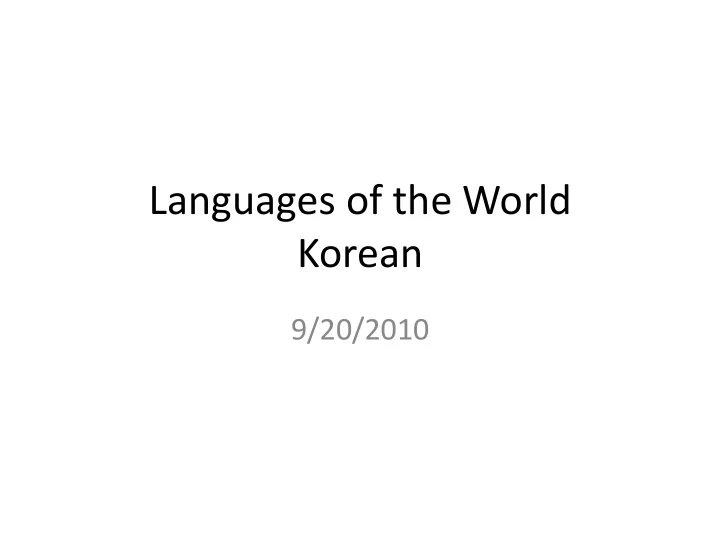

Languages of the World Korean 9/20/2010
Speakers • spoken in North and South Korean, each with various dialects and a different standard form • spoken by about 66,305,890 people (www.ethnologue.com), mostly in N. and S. Korea
Location
Phonetics/Phonology • 3-way distinction for all plosives between unaspirated lenis (lax), unaspirated fortis (tense) and aspirated • 2-way distinction for fricatives between lenis and fortis dental/alveola bilabial palatal velar r ㅂ ㄷ ㅈ ㄱ lenis p t c k ㅃ ㄸ ㅉ ㄲ plosives fortis pp tt cc kk ㅍ ㅌ ㅊ ㅋ p h t h c h k h aspirated ㅅ fricatives non-tense s ㅆ tense ss
Phonological changes of a morpheme • A morpheme is a part of a word with a meaning or function. – e.g. cat , - s (plural marker), ling- (linguist, lingual, bilingual) • Sound changes frequently occur when two morphemes come together (e.g. compounds words, attaching affixes)
Phonological Changes • In the following slides, we will examine some of the regular phonological changes in Korean. Keep in mind that there are other changes occurring as well.
What change is occurring? /nat/ → [nat] ‘cereal grains’ /nat h / → [nat] ‘piece, unit’ /nas/ → [nat] ‘sickle’ /nac/ → [nat] ‘daytime’ /nac h / → [nat] ‘face’ /ip/ → [ip] ‘mouth’ /ip h / → [ip] ‘leaf’
What change is occurring? /kip h -ni/ → *kim.ni+ ‘Is it deep?’ /cip+mun/ → [cim.mun] ‘house gate’ / cəc nɛmsɛ / → [ cən.nɛm.sɛ+ ‘milk smell’ /kkoc h +namu/ → *kkon.na.mu+ ‘flower tree’
What change is occurring? /kaps-i/ → [kap.ssi + ‘price’ (subject) /kip h -ta/ → [kip.tta + ‘to be deep’ / nɨc+ke / → [ nɨt.kke+ ‘late’ (adverb) /kuksu/ → [kuk.ssu + ‘noodles’ /mit h +patak/ → [mit.ppa.dak]
What change is occurring? /papo/ → [pabo] ‘idiot’ /totuk/ → [toduk + ‘thief’ /koki/ → [kogi + ‘meat’ /kalpi/ → [kalbi + ‘spare ribs’ /sam+to/ → [samdo + ‘three degrees’ / han+kɨl / → [ haŋgɨl+ ‘Korean alphabet’
What change is occurring? /k h oŋ+jəs/ → * k h oŋɲət+ ‘bean candy’ /os ip-ko/ → *oɲ.ɲip.kko+ ‘get dressed and ...’ /us-i/ →*uɲ.ɲi ] ‘upper tooth’ /hot h +ipul / →*hoɲ.ɲibul+ ‘sheet’
What change is occurring? /kkoc h +ip h /→ kkot+ip → kkot+ɲip → [ kkoɲ.ɲip ]
References Most data from: Sohn, Ho-Min (1999). The Korean language . Cambridge: Cambridge University Press.
Recommend
More recommend